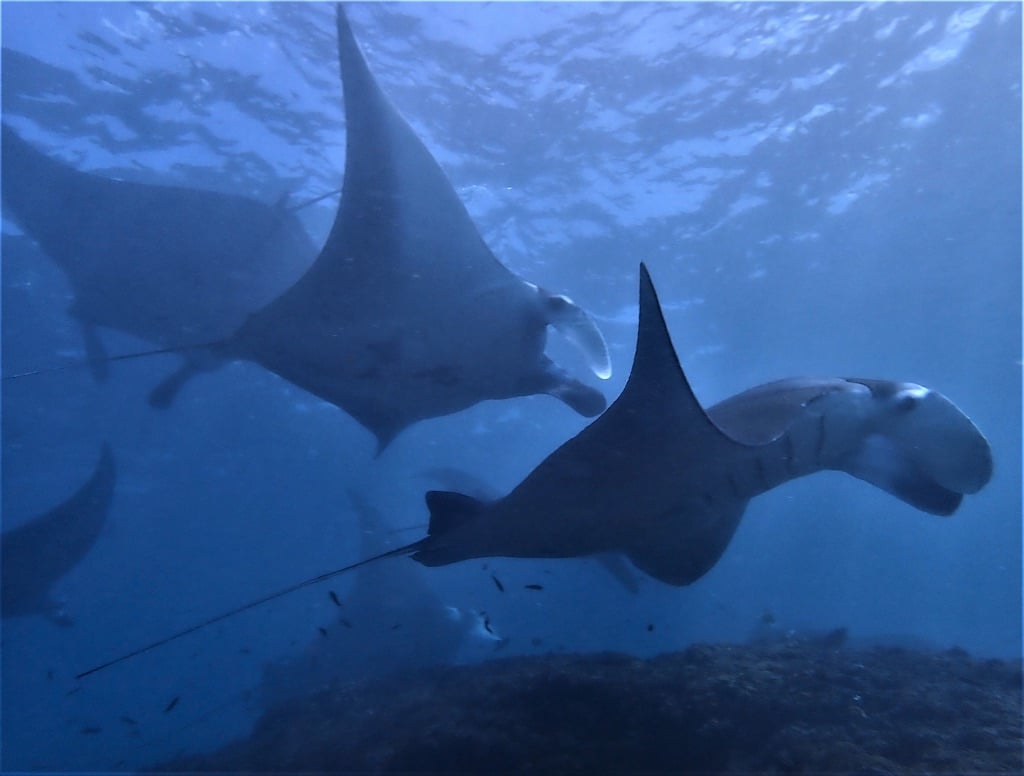Manta Point adalah salah satu situs selam paling populer di Pulau Nusa Penida. Tempat ini menawarkan kesempatan unik untuk menyelam bersama pari manta yang megah hampir setiap hari sepanjang tahun.
Nama situs ini berasal dari komunitas pari manta yang mendiami perairan dalam di sekitarnya. Para penyelam dan snorkeler sering disuguhi pemandangan menakjubkan saat makhluk ini naik ke perairan dangkal, di mana ikan-ikan karang kecil membantu membersihkan parasit dari tubuh mereka.
Penyelaman biasanya dimulai dari hamparan pasir, yang kemudian mengarah ke stasiun pembersihan pertama dari beberapa stasiun yang ada di lokasi ini.
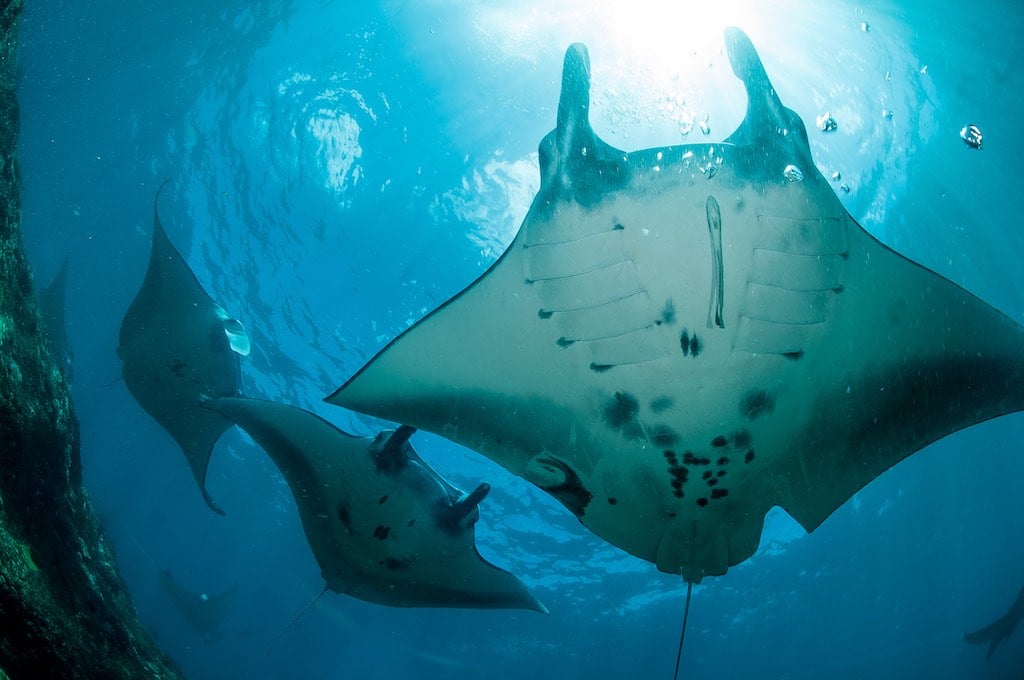
Apa yang Bisa Diharapkan di Manta Point Nusa Penida
Pertunjukan dimulai di formasi karang besar tempat kita dapat melihat pari manta berputar-putar seperti sedang terbang. Setelah beberapa saat, biasanya kita menyelam melintasi dataran karang luas dan penuh warna untuk mencapai stasiun pembersihan kedua. Di sana, kita dapat menikmati keanekaragaman hayati yang ada di Manta Point.
Akhirnya, penyelaman berlanjut ke dinding karang, untuk menemukan bebatuan dan formasi tertentu tempat kita bisa melihat hiu karang. Kadang-kadang, kita bahkan bisa beruntung bertemu makhluk yang lebih besar seperti Mola Mola atau bahkan hiu paus.
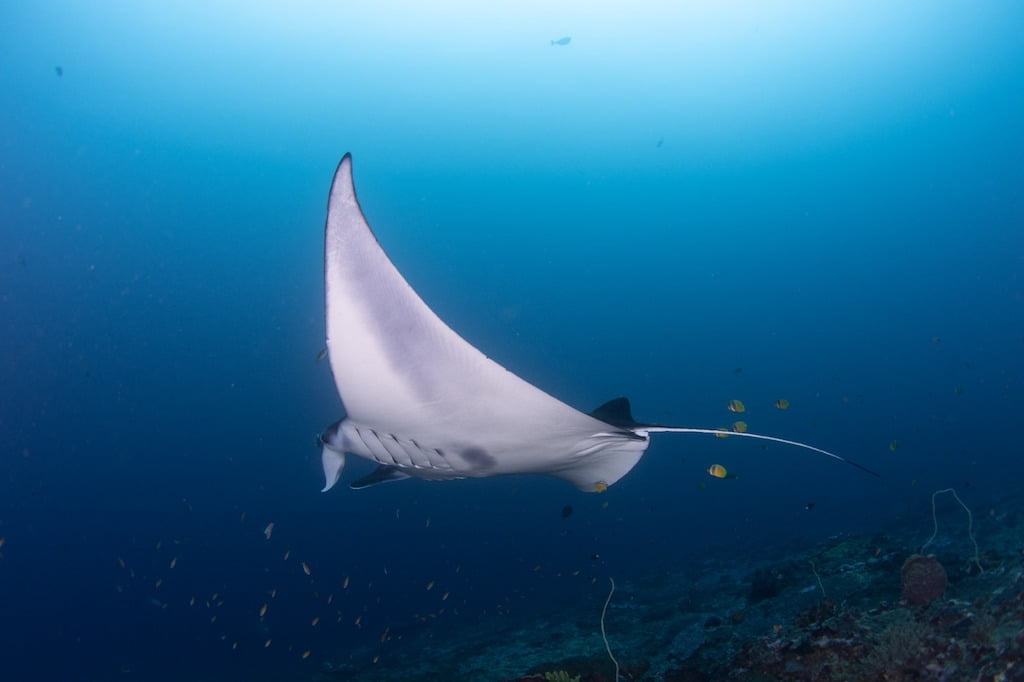
Manta Point terkenal dengan pari manta, tetapi juga merupakan situs selam luar biasa di mana berbagai jenis kehidupan laut bisa ditemui. Para penyelam sering menjumpai hiu bambu dan pari biru tutul di sini.
Selain itu, organisme kecil seperti nudibranch langka, udang Zanzibar, dan kepiting porselen juga sering menjadi sorotan penyelaman. Baru-baru ini, kami bahkan berkesempatan bertemu dengan ubur-ubur mahkota yang mengesankan.
Kami juga secara rutin melihat Mola Mola di dinding karang selama musimnya, dan bahkan pernah bertemu hiu paus!
Untuk informasi lebih lanjut tentang fauna laut di Bali, Anda dapat membaca panduan kami tentang menyelam di Nusa Penida.
Apa Itu Stasiun Pembersihan Pari Manta?
Situs ini memiliki beberapa karang besar yang berfungsi sebagai stasiun pembersihan bagi pari manta. Tetapi apa sebenarnya stasiun pembersihan itu?
Stasiun pembersihan adalah ekosistem kecil di mana pari manta terus-menerus berenang mengelilingi karang, sementara ikan pembersih—terutama jenis wrasse—menghilangkan bakteri dan mikroorganisme parasit dari tubuh mereka.
Selain itu, area ini kaya akan plankton, sehingga pari manta bisa sekaligus makan sambil dibersihkan.
Untuk informasi lebih lanjut tentang pari manta dan stasiun pembersihannya, silakan lanjut membaca panduan ini.
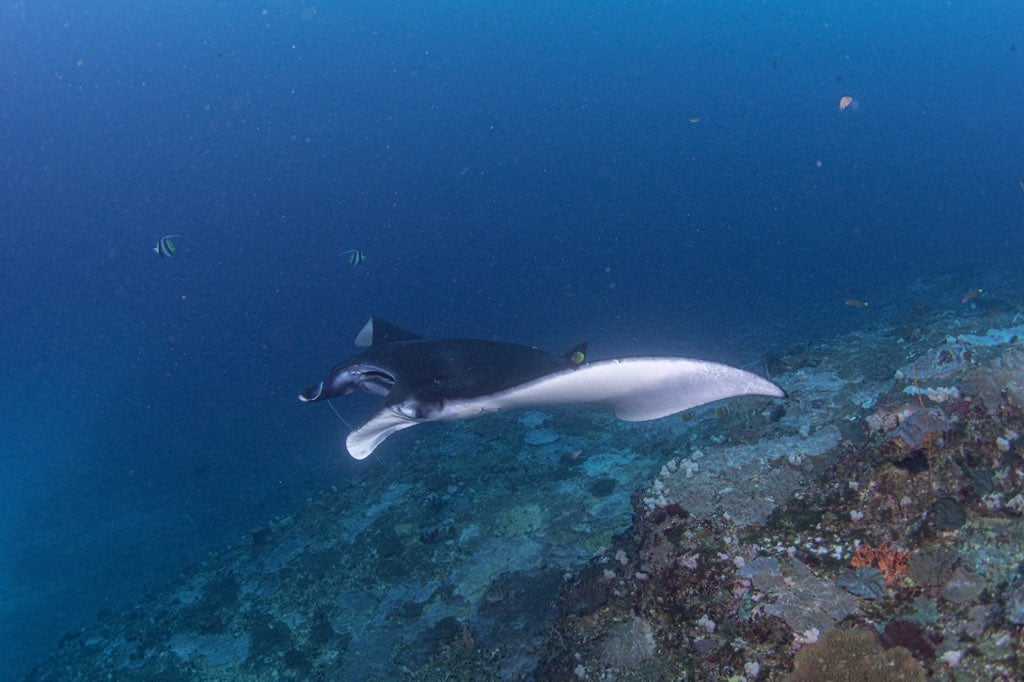
Di Mana Lokasi Manta Point Nusa Penida?
Manta Point terletak hampir di tengah pesisir barat daya Pulau Nusa Penida. Jika Anda melakukan perjalanan darat menuju Air Terjun Peguyangan, Anda akan menemukan tanda di sebelah kiri yang menunjukkan arah ke Manta Point.
Dekat dengan pura putih, Anda bisa menikmati pemandangan laut yang menakjubkan dari atas tebing, dan sering kali dapat melihat pari manta berenang di bawahnya.
Harap diperhatikan bahwa tidak ada akses langsung ke laut dari titik pandang ini. Untuk bisa berenang, snorkeling, atau menyelam bersama pari manta, Anda perlu menggunakan perahu.
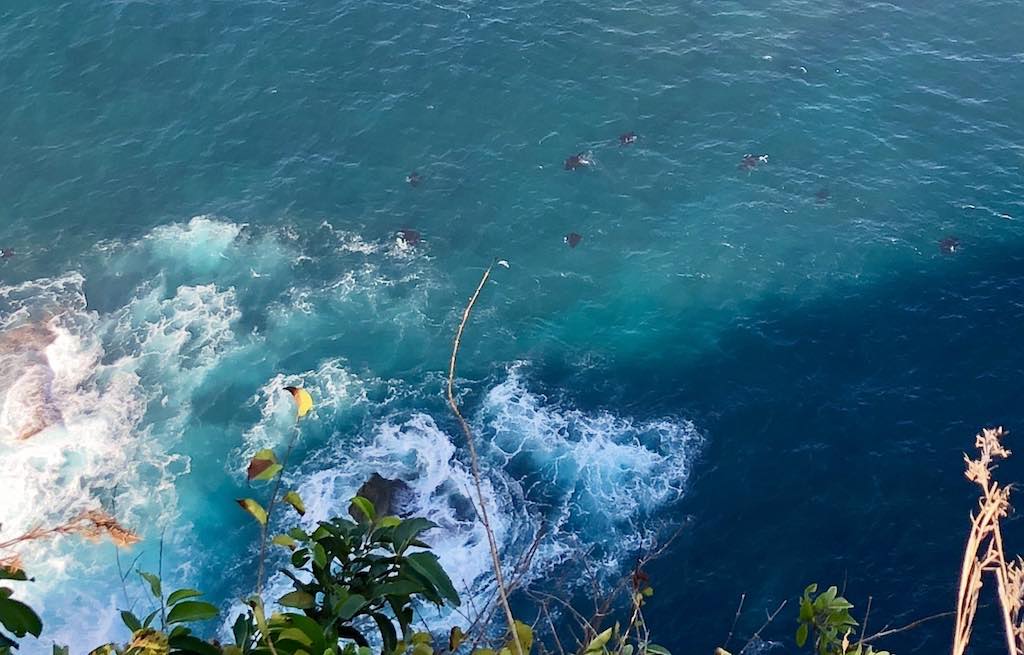
Perjalanan Menuju Manta Point
Perjalanan dengan perahu menuju Manta Point memakan waktu sekitar 45 menit dari Toyapakeh di Nusa Penida, dan kurang lebih sama dari Sanur di Bali. Perjalanan ini sangat menyenangkan karena dari perahu Anda bisa melihat banyak situs terkenal di Pulau Nusa Penida.
Segera setelah meninggalkan Toyapakeh, Anda akan melewati Adiwana Warnakali Dive Resort, Gamat Bay, Amok Sunset, dan kemudian Crystal Bay. Di sebelah kanan, Anda juga dapat melihat Pulau Nusa Ceningan dan Nusa Lembongan.
Selanjutnya, perahu akan berbelok ke kiri melewati Angel’s Billabong dan Broken Beach, lalu Pantai Kelingking, dan akhirnya Temeling serta Peguyangan, sebelum tiba di tujuan.
Dalam perjalanan kembali, biasanya kami berhenti sejenak untuk berfoto di depan Batu Bolong.
Bisakah Snorkeling di Manta Point? Manta Bay atau Manta Point?
Perusahaan snorkeling biasanya membawa pengunjung ke Manta Bay, yang terletak di depan Broken Beach, karena lokasinya lebih dekat. Di sini ada sekitar 80% kemungkinan untuk melihat pari manta. Namun, Anda mungkin akan menemui banyak perahu lain yang juga mencari mereka. Begitu kapten perahu Anda melihat manta, biasanya ia akan menyuruh Anda segera melompat ke air untuk kesempatan singkat berenang bersama manta — di tengah keramaian perahu dan snorkeler lainnya. Saya pernah mencobanya dan menurut saya pengalaman ini agak stres dan berbahaya.
Itulah sebabnya beberapa perusahaan snorkeling mulai membawa tamu mereka ke Manta Point. Snorkeling dengan pari manta di Manta Point memang jauh lebih baik dan lebih aman, karena para snorkeler diberi pengarahan terlebih dahulu, dan baik kapten maupun snorkeler biasanya lebih menghormati pari manta.
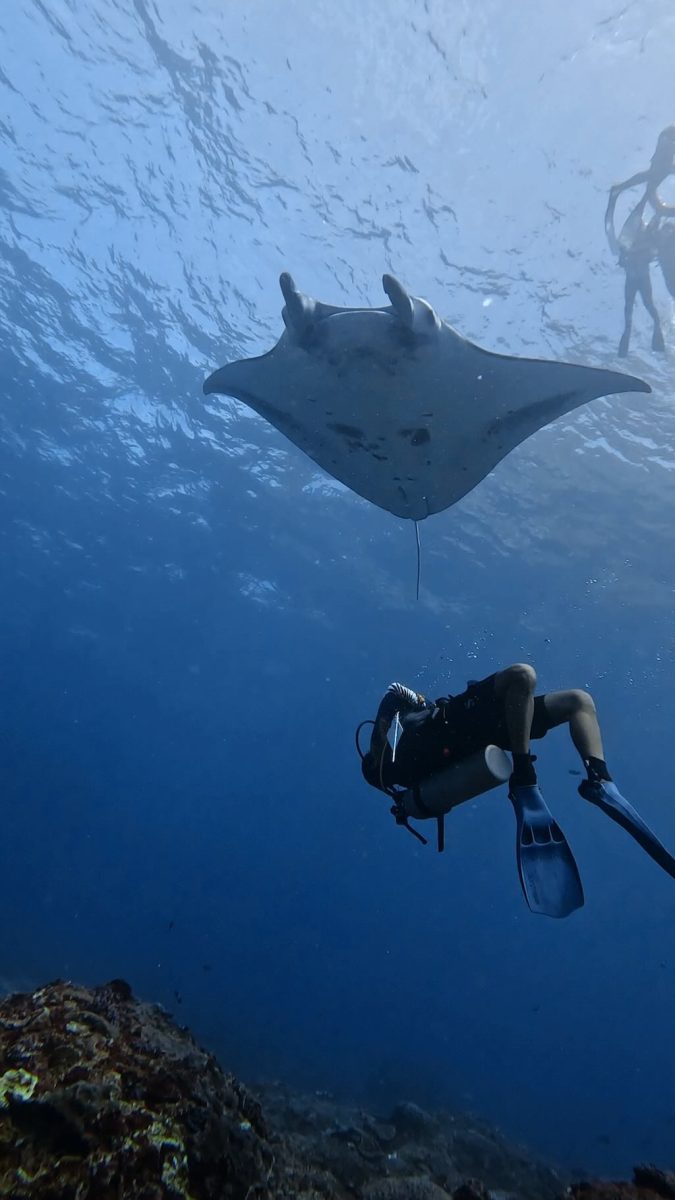
Bagaimana Memilih Snorkeling atau Diving di Manta Point?
Snorkeling dan scuba diving menawarkan dua cara berbeda namun sama-sama menakjubkan untuk bertemu dengan pari manta.
Snorkeling cocok untuk mereka yang lebih nyaman berada di dekat permukaan air. Dari sana, Anda bisa mengamati raksasa anggun ini meluncur di bawah Anda dalam air sebening kristal. Pengalaman ini seru sekaligus mudah diakses, sehingga sangat pas bagi pemula maupun non-diver. Disarankan untuk memilih tur dengan pemandu agar keamanan selalu terjamin.
Di sisi lain, scuba diving di Manta Point memberikan pengalaman yang lebih mendalam, memungkinkan penyelam berada lebih dekat dengan pari manta di stasiun pembersihan mereka. Diving menawarkan interaksi yang lebih lama dan lebih dalam, serta kesempatan menjelajahi keanekaragaman hayati laut di sekitarnya, termasuk hiu karang dan formasi karang berwarna-warni.
Jika snorkeling memberi Anda sekilas perjumpaan yang cepat namun menggetarkan dengan pari manta, maka diving di Manta Point adalah cara terbaik untuk sepenuhnya mengagumi ukuran, keanggunan, dan perilaku mereka di habitat alami. Kami dengan senang hati dapat memperkenalkan Anda pada discovery dive bersama pari manta — benar-benar pengalaman yang luar biasa!
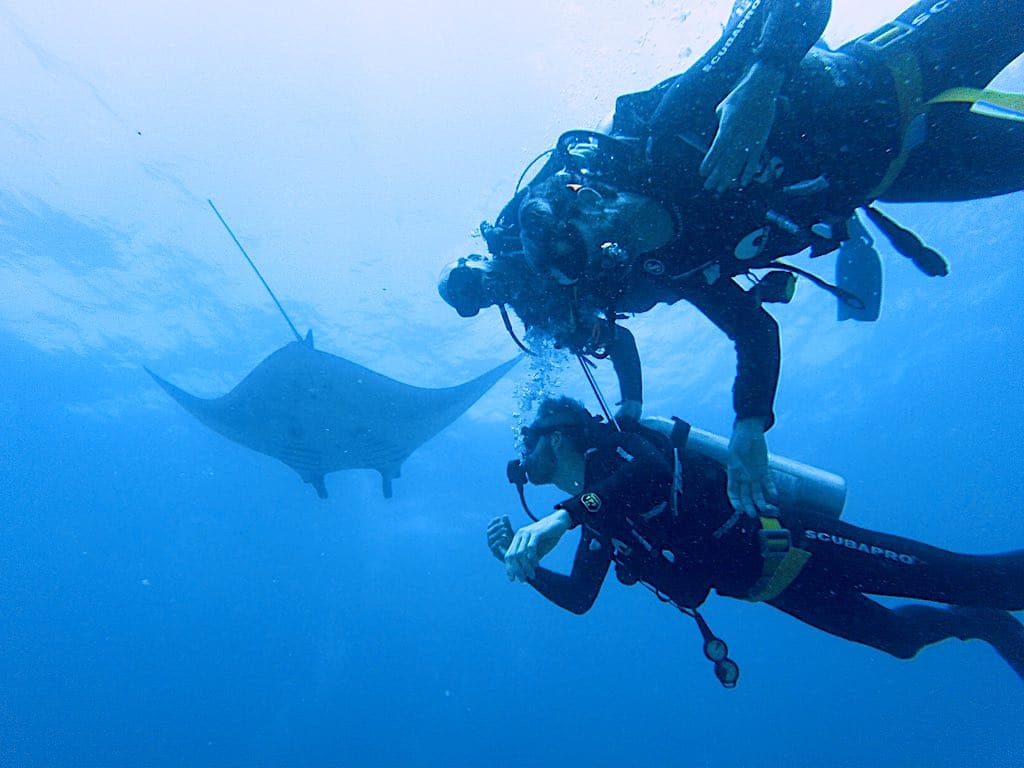
Seberapa Dalam Manta Point?
Area paling dangkal di teluk ini memiliki kedalaman sekitar 8 meter, sementara kedalaman maksimalnya mencapai 12 meter. Kondisi ini menjadikannya lokasi yang sangat baik untuk discovery dive, karena pari manta biasanya ditemukan antara permukaan hingga 10 meter.
Bagi mereka yang mencari penyelaman lebih menantang, terdapat bagian teluk yang jauh lebih dalam dengan kedalaman hingga 40 meter, lengkap dengan berbagai formasi dan relief bawah laut.
Kapan Waktu Terbaik untuk Menyelam di Manta Point Nusa Penida?
Pari manta biasanya hadir sepanjang tahun, kecuali saat musim kawin, ketika mereka berkumpul di perairan yang lebih dalam untuk berkembang biak. Faktor seperti polusi, suhu air, dan kondisi cuaca dapat memengaruhi keberadaan mereka. Selain itu, laut kadang bisa cukup bergelombang sehingga menyulitkan untuk berangkat. Kami akan selalu memberi tahu jika kondisi tidak ideal.
Manta Point juga semakin ramai, sering dipenuhi oleh banyak penyelam. Untuk menghindari kerumunan, Dune Penida biasanya menyesuaikan waktu penyelaman, berusaha tiba sebelum atau sesudah jam sibuk pusat-pusat selam lainnya. Selain itu, kami juga menjelajahi area lain di dalam situs selam ini jika satu area terlalu penuh.
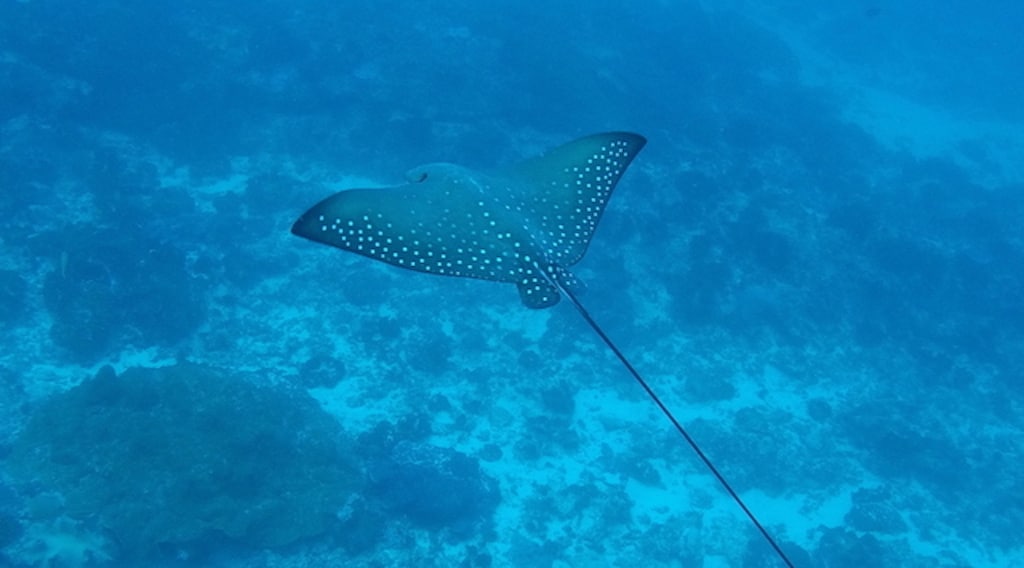
Pari Manta atau Manta Globula?
Setiap pari manta itu unik. Memang mungkin untuk mengenali masing-masing pari manta dari pola di bagian perutnya, layaknya kartu identitas atau sidik jari. Dengan cara ini, para penyelam dapat dengan mudah menghitung atau bahkan mengenali mereka.
Di Warnakali, kami menyukai seekor pari yang dijuluki Black Mama, yang benar-benar berwarna hitam dan berukuran sangat besar. Anak-anaknya juga hampir seluruhnya berwarna hitam, hanya saja ukurannya lebih kecil.
Kemungkinan besar Anda tidak akan bisa membedakan antara pari manta dan manta globula, yang ukurannya lebih kecil dan memiliki mulut di bagian bawah tubuh (ventral).

Di Manta Point, Bukan Hanya Pari Manta!
Sedikit menjauh dari stasiun pembersihan, terdapat gua-gua kecil yang sangat cocok untuk eksplorasi santai. Situs ini juga luar biasa beragam, dengan kekayaan kehidupan makro. Anda dapat menemukan kepiting, ikan badut (clownfish), ikan surgeon, butterflyfish, rabbitfish, serta berbagai biota laut endemik pulau ini. Baru-baru ini, kami bahkan berkesempatan bertemu dengan ubur-ubur mahkota yang menakjubkan.
Anda juga bisa melihat pari listrik, pari elang, pari marmer, dan dengan sedikit keberuntungan, hiu blacktip reef serta hiu bambu. Selain itu, ada kemungkinan bertemu dengan penyu serta berbagai jenis nudibranch, beberapa di antaranya cukup langka.
Dan untuk menambah sensasi, kami juga sudah beberapa kali bertemu dengan Mola Mola di sini! Bahkan pada 13 September 2023, seekor hiu paus sempat terlihat!
Karakteristik Manta Point
- Waktu terbaik: menyelam sepanjang tahun
- Jenis penyelaman: terumbu karang, fotografi, pelatihan, identifikasi ikan, makro
- Kedalaman: 8 hingga 35 meter
- Tingkat penyelam: dari discovery diver hingga penyelam berpengalaman
- Visibilitas: 10 – 20 meter
- Arus: tidak ada hingga lemah, dengan kemungkinan ombak
- Akses: 45 menit perjalanan perahu dari Toyapakeh, dengan rute perahu yang indah di sepanjang pantai barat Pulau Nusa Penida
- Suhu air: 20 – 27 °C
- Fauna & Flora: pari manta, pari listrik (sting ray), pari marmer, pari elang, hiu blacktip, hiu bambu, kepiting, ikan badut (clownfish), ikan surgeon, butterflyfish, rabbitfish
